- Home Page
- Popular Kites
- Sled Kites
Sled Kites
Simply Convenient!
Sled kites have two big things going for them—simplicity and convenience! Plus, the stick-spar variety are super-easy to make for yourself.
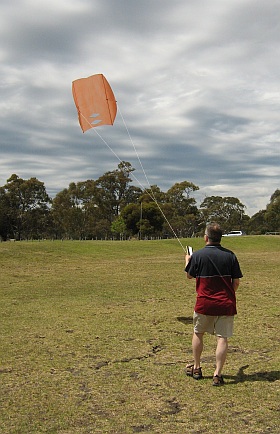 Testing the MBK Dowel Sled
Testing the MBK Dowel SledThe simplest kind of sled is just a single sheet of sail material with a couple of vertical sticks attached.
A
simple bridle loop is attached to the left and right extremities of the
sail. There is no adjustment, no fuss. Just unroll, attach a flying line, and
you're up and away!
See our big orange MBK Dowel Sled in the photo, being tested for the first time. As I remember, gusts can pull on tension very quickly with this type of kite. If it catches you by surprise, you can end up with line burn to a finger or two!
As you can see, this design flies very nicely without tails! You can add them if you want to, just for looks.
Personally, I like the convenience of tailless kites. There's nothing to blow
around in the wind and get tangled while the kite is being handled on
the ground.
We've been to a few kite festivals over the years and taken plenty of photos. There's a few sled pictures among them, so see further down for a few examples of the variety.
On this site, there's more kite-making info than you can poke a stick at. :-)
Want to know the most convenient way of using it all?
The Big MBK E-book Bundle is a collection of downloads—printable PDF files which provide step-by-step instructions for many kites large and small.
Every kite in every MBK series.
Sled Kites We've Seen at Festivals
Here are four sleds, each with something unique about it:
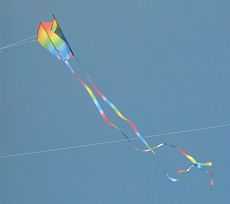 A "sticked" sled
A "sticked" sledThere are so many variations on the theme that are possible, just in terms of configuration—let alone decoration and tails! However, in my books, a sled always has a single-surface sail.
Here's a really simple one to start with. This sled uses the classic "two sticks and a sail" approach. The rainbow color scheme is carried through to the long twin tails.
Two tails are the most natural way to decorate or stabilize a sled, since the two spar tips provide convenient anchor points. Also, there is no distortion of the inflated sail in flight.
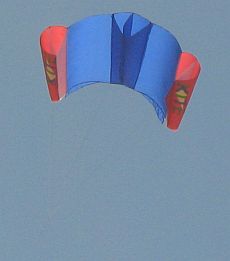 Another variation of a soft sled
Another variation of a soft sledHere's an interesting design! Like some early rigid-spar sleds, this one has a central spar in addition to the other two.
The central spar is partitioned, and
it's a bit hard to see, but it looks like the side spars are as well.
There seems to be some light-colored fabric in there. Would you agree?
Something I didn't notice straight away is the flat inside edges of the side spars! I guess this might be to add "walls" on each side of the airflow just like the side flaps of a simple sled. If you get what I mean.
There are definitely no keels on this kite. Or at least that's what I thought until I spotted that tiny triangular area under one spar. It's near the bottom right of the image.
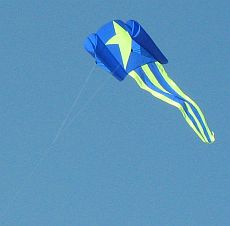 A "soft" sled
A "soft" sledHere's a slightly more complex sled, featuring inflatable spars.
Air pressure keeps some rigidity in the tube spars on each side, so the whole thing works just like a simple sled in flight. The spars are also partitioned in half. Perhaps this helps to prevent them collapsing; I'm not sure.
Despite what I said for the first kite up there, this one does have a tail attached to the trailing edge of the sail! However, look how broad it is.
My hunch is that the tail is so broad that the top portion of the tail is effectively part of the main sail.
They might just be for convenience in attaching the bridle, but this sled also has a tiny keel on each side. See if you can spot them. They don't look big enough to have much effect on stability.
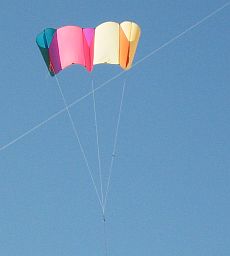 And another
And anotherFinally, this sled is really no more complex than the last one, but there is a real difference! It's a double sled, with each side looking somewhat like a single sled kite! In other words, the sail has two distinct curvatures, separated by the deep central inflatable spar.
There must be a real advantage to using partitions in those inflatable spars. The side spars on this kite have them too.
The three-leg bridle is very visible in the picture, unlike the very small keels to which the lines are attached.
There's our own homemade Multi-Dowel Sled in action, above. That's about it for this page on sled kites. We hope you enjoyed the pics and the info!
As mentioned earlier, there's more kite making on this site than you can poke a stick at. :-)
Want to know the most convenient way of using it all?
The Big MBK E-book Bundle is a collection of downloads—printable PDF files that provide step-by-step instructions for many kites large and small.
That's every kite in every MBK series.
